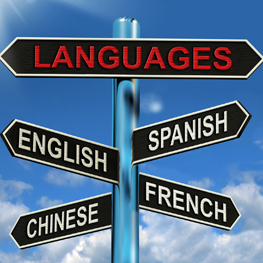
Here are some ways speaking two or more languages primes a child’s brain to be receptive and ready to learn at school. Outdated advice warned parents learning more than one language at a time could be a disadvantage for their child because it would slow language development. However, recent research on brain functioning shows kids from bilingual families actually have a unique advantage as students, due to the healthy workout their brain has accomplished in acquiring two languages. Developing fluency in one or more language is an activity that can really be a benefit to a child as a student.
A brain that is ready to learn
The brain tends to work like a quick search engine to interpret language. It deciphers language by guessing what each word will be as it hears the speaker say each syllable of a conversation. When a child can speak two languages or more, their mind works double-time to guess words, with choices from multiple languages. This process exercises the side of the brain used for coding and deciphering, which primes it for when they use these skills at school and throughout their lives.
Focusing on follow-through
The part of the brain used to process language is also involved in executive functioning skills. These skills are essential for school success and include staying focused, following through to complete tasks and easily transitioning from one activity to another. Amanda Martinka, an elementary school teacher, says when children translate words from one language to another, these skills are similar to the ones used when solving a math problem. Both processes involve sorting information, maintaining the different pieces and then applying them. These key elements build a receptive learner, and are critical skills teachers try to encourage in their students.
Building knowledge they can use
Some parents may shy away from sharing books in their native language with their children because they are concerned it will divide their attention and take away from learning a second language. Martinka says reading books, singing songs and working on letters and sounds teaches the concepts of literacy - no matter what language it is taught in. Mika, mom of two, teaches her preschool-age children the alphabet in Japanese and songs and stories in Japanese and English. Being fluent in more than one language also teaches kids to use multiple viewpoints. Steven Nishida, owner of English Masters Communication Center, says these skills are extremely helpful for a child’s communication and problem-solving skills. Children who are used to using words from multiple languages may be less likely to give up when they get stuck because they are used to using multiple approaches to understanding a problem or communicating an idea.
Music to their ears
Learning a language also uses the same part of the brain that processes music. “Music is a language, and notes are symbols that are interpreted, like words. Music and language makes a child’s mind work at both a sight and hearing level,” says Liz Plunkett, an elementary music specialist. Reading music and identifying pitch and tone are skills enhanced by the brain’s activity on language development first. Children who are raised interpreting and understanding two or more languages will find that learning about music feels like a familiar process.
Roots and wings
Taking your child to visit festivals and celebrating cultural holidays with them is a way to share language and culture, acquire knowledge and build a bilingual learner with a strong personal and cultural identity. The benefits to feeling connected to family, culture and identity are important parts of becoming a confident student. In Martinka’s class, she sees that kids who feel connected to their family and culture have confidence for learning and the confidence to verbally participate in class. When your child shares traditions and celebrations with the teacher and the class, the child becomes more engaged and can make a connection with the teacher and the class. Participating in class instead of being a silent learner gives a child a sense of self and helps them to see they have an important voice.
Different families have different approaches to bilingualism, and diversity is part of what builds a unique and proficient learner. Every child is unique; but studies support that learning more than one language can create an open mind that is ready to acquire more knowledge and lifelong skills. These primed abilities and engaged brains build a confident kid, and a student who may become an observant scientist, a unique artist, a detail-oriented programmer or a parent who passes down a legacy of cultural identity and language to generations of confident, engaged kids!
Ruth is the parent of two girls, and she feels parents are the most influential teachers for their children, which are both an honor and a delight.
Calgary’s Child Magazine © 2024 Calgary’s Child